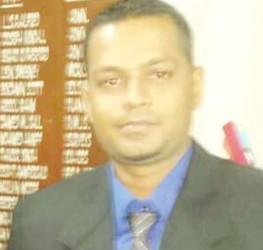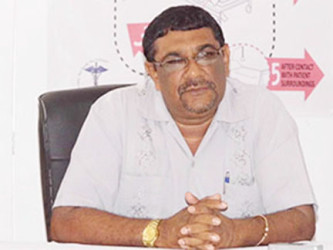Thousands of acres of paddy across Regions two, three, five and six are under threat due to a lack of adequate water and full blown water rationing is on the agenda if the situation worsens.

Region Two Chairman Devanand Ramdatt told Stabroek News on Thursday that “we are now giving priority to farmers who would have cultivated, meaning that we have to give those who have sown priority to save their rice.”
He said that currently rice fields are being irrigated from the Pomeroon River but there is significant worry over possible salt in the water. “We already have inadequate water in the system so you cannot afford to focus on new cultivation, unfortunately,” the chairman noted.
Ramdatt, who has had a contentious relationship with the Regional Executive Officer (REO) of Region Two, Rupert Hopkinson, told Stabroek News that “we are calling on the REO to make sure he has a strong monitoring system, the rangers and overseers that they closely monitor. They should meet with farmers, we met with the GRDB [Guyana Rice Development Board]. We asked to do an advisory, if farmers haven’t ploughed and sown that they should not proceed to do that at this time because priority would have been given to famers who have sown their crop. I think generally the NDIA [National Drainage and Irrigation Authority], the rangers and overseers, the superintendents from the department have to be at the statutory meeting of RDC [Regional Democratic Council]. It was indicated that they (also) have to be in the fields.”

He said that the Good Hope Relief structure, located at Good Hope, Region Two (Pomeroon-Supenaam), is falling apart and as a result the water wastage is heavy. He noted that the regional engineers have determined that to redo the structure would cost $35M and he was made to understand that the project would be in the 2016 Budget.
The Chairman told this newspaper that he had written separately last year to both the Agriculture Minister Noel Holder and the Prime Minister Moses Nagamootoo explaining the issue. He said that he also tried to communicate with the REO about the Good Hope Relief structure requiring urgent attention but to no avail.
Predicament
Ramdatt said that since October last year he has been trying to have the REO understand the gravity of the situation and the predicament that farmers will find themselves in for the first crop of 2016 because of El Niño which has created arid conditions in Guyana. He said that if the water issue had been first addressed when he raised it, stiff measures such as water rationing and the need to have some farmers not participate in the first crop cultivation would not have been on the agenda.

“Let me tell you, 17,000 acres under cultivation is under threat in the Mahaicony/Mahaica boundary. The other part of Region Five, Abary to Berbice River is taken care of by the MMA [Mahaica, Mahaicony, Abary-Agricultural Development Authority] and those farmers have enough water, they have a system to get fresh water from the Conservancy. The Mahaicony/ Mahaica there isn’t any system like that where they can access from the Conservancy so the farmers rely on the rivers, but presently the salt water from the sea is moving inland and within a week or two farmers will not be able to access the fresh water for their crops,” Region Five Chairman Vickchand Ramphal told Stabroek News on Thursday.
He said that currently “4000 acres is already being affected by the salt water. Farmers because they did not receive the necessary help in terms of testing the water …they went and irrigated and the salt water got in because they could not properly test.”
He said that the region just doesn’t have enough resources in terms of excavators and other necessary machinery to undertake the work needed to ensure that the canals are kept clean. Ramphal told Stabroek News that the NDIA and the MMA were charged with the maintenance of necessary canals, but there has been some delinquency and given the water scarcity now this issue has become a matter for serious concern.
He noted that canals which would bring in fresh water have been overrun by weeds. He stated that small-scale farmers are being hit the worst. The cost of hiring persons with equipment to assist in the fields coupled with rent and now a water scarcity has many farmers struggling to continue with their crops.
“It is mostly small farmers that are being affected. What happened, the small farmers they do not have any equipment. They will hire or pay people to do it and this time around because of the low paddy price it is not profitable to pay someone,” he stated.
Chancing it
“We got about 60,000 acres under cultivation, about 5,000 might not be planted this year. The price and the late supply of water to the front areas, it is preventing farmers from chancing it,” Region Six Chairman David Armogan told Stabroek News.
“We have to pump from Black Bush to the front lands so we have sufficient water,” he explained. He added however that before the water reaches the front lands, the farmers of Black Bush would have utilised large amounts so the time it takes for the water to reach all the necessary areas will impact the time frame that farmers have to sow paddy.
He said “what is happening if this dry weather continues, the creek itself will start dropping and we will end up with salt because we are pumping from way back Canje. The dry weather continues and we may run into a real problem.”
Armogan noted that two pumps were down and a decision by the Agriculture Ministry was made late to replace the two engines at a cost of between $10-12M through the NDIA. He said that the area has six pumps operating now, but given the current dry weather and no end to it, more intervention was needed.
He said that central government should step in and assist with fertiliser and other costs. He also noted that there needed to be future provisions for rent control. He noted that the price of paddy hovers at $2000-2200 per bag of paddy while the cost of production is still between $2500-2700 per bag. Coupled with rent to overseas landlords there is very little hope for small-scale farmers to survive.
Former Agriculture Minister Dr Leslie Ramsammy recently told Stabroek News that “A rice farmer expends about $60,000 to $100,000 per acre. The smaller farmers are closer to the $100,000 per acre. Clearly with a yield of about 35 bags per acre, a farmer is spending more like $2,800 per bag. Unless he gets greater than $3000 per bag he cannot make any money. The larger farmers will make a small profit per bag. But the small farmers cannot. In Essequibo most of the farmers are small farmers.”
He said in a subsequent statement that “only about 70% of land targeted for rice cultivation has been sown at this time, a time considered too late for farmers to continue to sow paddy seeds. In addition, almost 400,000 tons of paddy sits in mills around the country, carried over from the last crop. It is the first time that Guyana has had to deal with such a large carry-over of paddy since our export in 2015 did not keep up with production.
“As 2016 rolls out, the signals are alarming. First from close to 100,000 hectares, the target has been reduced by about 8% to about 91,000 hectares for the first crop in 2016. Thus, even with a target of 5.5 tons per hectare as a target, the overall paddy production target for the first crop is just 502,000 tons or 330,000 tons of rice equivalent. Even with the reduced target, only 70% overall of the targeted acreage have been sown so far. It is looking like at least a 15% reduction in land cultivation will be the result for the first crop. This means that Guyana could see a reduced rice production for 2016,” Ramsammy stated.








